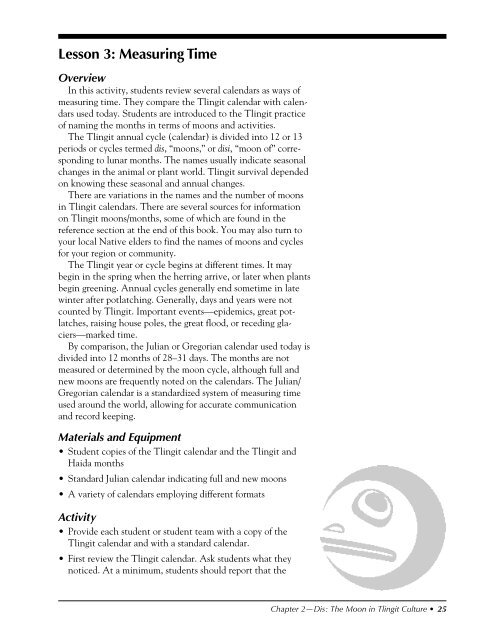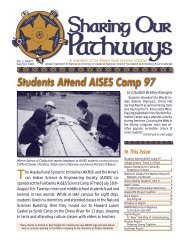Tlingit Moon & Tide - Alaska Native Knowledge Network - University ...
Tlingit Moon & Tide - Alaska Native Knowledge Network - University ...
Tlingit Moon & Tide - Alaska Native Knowledge Network - University ...
You also want an ePaper? Increase the reach of your titles
YUMPU automatically turns print PDFs into web optimized ePapers that Google loves.
Lesson 3: Measuring Time<br />
Overview<br />
In this activity, students review several calendars as ways of<br />
measuring time. They compare the <strong>Tlingit</strong> calendar with calendars<br />
used today. Students are introduced to the <strong>Tlingit</strong> practice<br />
of naming the months in terms of moons and activities.<br />
The <strong>Tlingit</strong> annual cycle (calendar) is divided into 12 or 13<br />
periods or cycles termed dis, “moons,” or disi, “moon of” corresponding<br />
to lunar months. The names usually indicate seasonal<br />
changes in the animal or plant world. <strong>Tlingit</strong> survival depended<br />
on knowing these seasonal and annual changes.<br />
There are variations in the names and the number of moons<br />
in <strong>Tlingit</strong> calendars. There are several sources for information<br />
on <strong>Tlingit</strong> moons/months, some of which are found in the<br />
reference section at the end of this book. You may also turn to<br />
your local <strong>Native</strong> elders to find the names of moons and cycles<br />
for your region or community.<br />
The <strong>Tlingit</strong> year or cycle begins at different times. It may<br />
begin in the spring when the herring arrive, or later when plants<br />
begin greening. Annual cycles generally end sometime in late<br />
winter after potlatching. Generally, days and years were not<br />
counted by <strong>Tlingit</strong>. Important events—epidemics, great potlatches,<br />
raising house poles, the great flood, or receding glaciers—marked<br />
time.<br />
By comparison, the Julian or Gregorian calendar used today is<br />
divided into 12 months of 28–31 days. The months are not<br />
measured or determined by the moon cycle, although full and<br />
new moons are frequently noted on the calendars. The Julian/<br />
Gregorian calendar is a standardized system of measuring time<br />
used around the world, allowing for accurate communication<br />
and record keeping.<br />
Materials and Equipment<br />
• Student copies of the <strong>Tlingit</strong> calendar and the <strong>Tlingit</strong> and<br />
Haida months<br />
• Standard Julian calendar indicating full and new moons<br />
• A variety of calendars employing different formats<br />
Activity<br />
• Provide each student or student team with a copy of the<br />
<strong>Tlingit</strong> calendar and with a standard calendar.<br />
• First review the <strong>Tlingit</strong> calendar. Ask students what they<br />
noticed. At a minimum, students should report that the<br />
Chapter 2—Dis: The <strong>Moon</strong> in <strong>Tlingit</strong> Culture • 25



